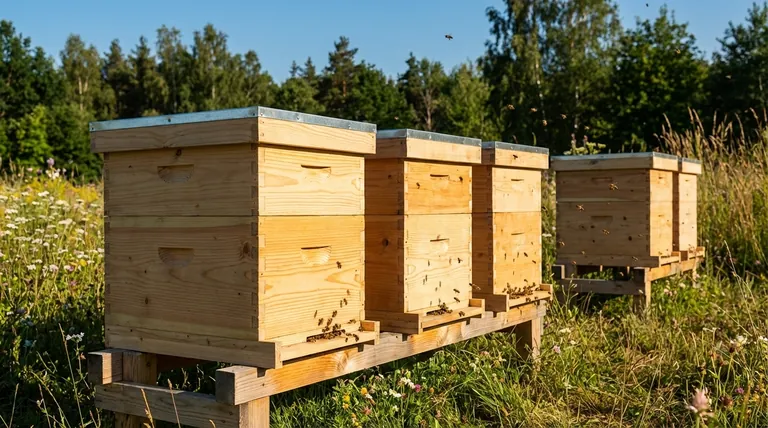The primary advantages of wooden hives stem from their natural material properties, which create a healthier environment for bees, and their modular design, which offers significant practical benefits for the beekeeper. They provide superior insulation and breathability compared to alternatives, are generally more cost-effective, and allow for easy maintenance and storage.
Wooden hives are the industry standard for a clear reason: they create an optimal internal climate that promotes colony health while offering beekeepers an affordable, customizable, and time-tested system for managing their apiary.

A Superior Environment for Bee Health
The material of a hive directly impacts the colony's ability to thrive. Wood offers several key environmental benefits that synthetic materials often cannot replicate.
Natural Insulation and Climate Control
Wood is an excellent natural insulator. This property helps the colony maintain a consistent internal temperature, shielding them from both extreme summer heat and winter cold.
Stable temperatures reduce stress on the bees, allowing them to expend less energy on thermoregulation and more on foraging and brood-rearing. Insulated inner covers can further enhance this effect, trapping heat and preventing fatal condensation.
Excellent Breathability
Unlike plastic, wood is a breathable material. This allows for the slow exchange of air, which is critical for managing moisture and humidity levels within the hive.
Proper ventilation prevents the buildup of condensation, a common problem in non-porous hives that can lead to disease and can be fatal to the colony during winter.
A Familiar and Natural Habitat
Bees have evolved for millions of years making their homes in hollowed-out trees. A wooden hive provides a familiar and comfortable habitat that closely mimics their natural environment.
This natural setting is believed to contribute to a calmer, healthier colony and can even complement the natural aroma and flavor profile of the honey they produce.
Practical Benefits for the Beekeeper
Beyond colony health, wooden hives offer tangible advantages in cost, handling, and long-term management.
Cost-Effectiveness
Wooden hives are generally cheaper to purchase than their plastic counterparts. This lower initial investment makes them an accessible starting point for new beekeepers.
Modularity and Easy Maintenance
The Langstroth hive, the most common wooden design, is completely modular. Components like boxes, frames, and covers can be easily separated, interchanged, and replaced.
This design makes inspections, honey harvesting, and pest management more efficient. It also means individual components can be disassembled for compact storage during the off-season.
Lighter Weight
On a component-by-component basis, wood is typically lighter than solid plastic alternatives. This makes lifting and moving hive boxes less strenuous for the beekeeper.
Understanding the Trade-offs
While the advantages are significant, a balanced perspective is crucial. The natural properties of wood also come with specific responsibilities.
The Need for Assembly and Finishing
Most new wooden hives are sold as unassembled kits. Beekeepers must be prepared to assemble the boxes and frames themselves, which requires basic tools and time.
Maintenance Against the Elements
Unlike plastic, untreated wood will rot and warp when exposed to weather. To ensure longevity, wooden hives must be protected with a non-toxic paint or sealant, which adds an extra step and recurring maintenance.
Making the Right Choice for Your Apiary
Your specific goals as a beekeeper will determine which material benefits are most important for your operation.
- If your primary focus is optimal bee health: The natural insulation and breathability of wood make it the superior choice for creating a stable, low-stress environment.
- If your primary focus is budget and flexibility: The lower initial cost and highly modular nature of wooden hives provide unmatched financial and operational advantages.
- If your primary focus is ease of use: Be prepared to invest the initial time in assembly and regular maintenance to protect your wooden hives and ensure their long-term value.
Ultimately, choosing a wooden hive is an investment in a proven system that prioritizes both the well-being of the colony and the practical needs of the beekeeper.
Summary Table:
| Aspect | Key Advantage |
|---|---|
| Bee Health | Superior natural insulation and breathability for a stable, low-stress environment. |
| Cost | Generally more affordable initial investment than plastic alternatives. |
| Management | Modular design allows for easy inspection, honey harvesting, and compact storage. |
| Weight | Lighter than many solid plastic hives, making handling easier. |
Ready to equip your apiary with the proven benefits of wooden hives?
At HONESTBEE, we supply high-quality, durable beekeeping supplies and equipment designed for the needs of commercial apiaries and beekeeping equipment distributors. Our wholesale-focused operations ensure you get the reliable gear you need to support healthy, productive colonies.
Contact us today to discuss your needs and discover how our solutions can contribute to the success of your beekeeping operation.
Visual Guide

Related Products
- Langstroth Bee Hives Bee Keeping Box for Beginners Beekeeping
- Wholesales Dadant Size Wooden Bee Hives for Beekeeping
- Long Langstroth Style Horizontal Top Bar Hive for Wholesale
- Professional Drop-Style Hive Handles for Beekeeping
- Professional Insulated Plastic Bee Hives
People Also Ask
- Why might a beginner be advised to start with a Langstroth hive? Unlock a Supportive Beekeeping Ecosystem
- Why are Langstroth hives recommended for beginners? Unmatched Support & Standardization
- What are the key features of the Langstroth beehive? A Guide to the Standard for Modern Beekeeping
- Should a beginner try a different type of hive? Start with a Langstroth for a solid foundation.
- What are the different types of beehive boxes available? Choose the Right Hive for Your Apiary



















